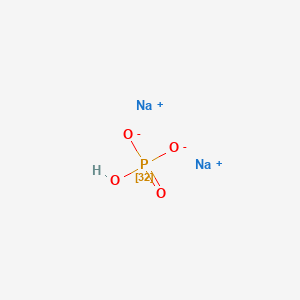
Thiamine
Übersicht
Beschreibung
Thiamine, also known as vitamin B1, is a water-soluble vitamin that is essential for human health. It was the first B vitamin to be discovered and plays a crucial role in the metabolism of carbohydrates, fats, and proteins. This compound is found in various foods, including whole grains, legumes, and some meats and fish. It is also commercially synthesized for use as a dietary supplement and medication .
Vorbereitungsmethoden
Synthesewege und Reaktionsbedingungen: Thiamin kann über verschiedene chemische Wege synthetisiert werden. Ein gängiges Verfahren beinhaltet die Reaktion von 4-Methyl-5-(2-Hydroxyethyl)thiazol mit 2-Methyl-4-Amino-5-Chlormethylpyrimidin unter basischen Bedingungen, um Thiamin zu bilden . Die Reaktion erfordert typischerweise ein Lösungsmittel wie Methanol und eine Base wie Natriumhydroxid.
Industrielle Produktionsmethoden: In industriellen Umgebungen wird Thiaminhydrochlorid häufig durch Reaktion von Thiaminnitrat mit Salzsäure hergestellt. Das Verfahren umfasst das Erhitzen von konzentrierter Salzsäure, das Abkühlen und Trocknen des desorbierten Chlorwasserstoffgases und die anschließende Einführung in eine Methanolösung von Thiaminnitrat. Das resultierende Thiaminhydrochlorid wird dann filtriert, gewaschen und getrocknet .
Analyse Chemischer Reaktionen
Arten von Reaktionen: Thiamin durchläuft verschiedene chemische Reaktionen, darunter:
Oxidation: Thiamin kann oxidiert werden, um Thiochrom zu bilden, eine fluoreszierende Verbindung, die in der analytischen Chemie verwendet wird.
Phosphorylierung: Thiamin wird phosphoryliert, um Thiaminpyrophosphat zu bilden, ein essentielles Coenzym in Stoffwechselreaktionen.
Häufige Reagenzien und Bedingungen:
Oxidation: Kaliumhexacyanoferrat(III) wird häufig als Oxidationsmittel verwendet, um Thiamin in Thiochrom umzuwandeln.
Phosphorylierung: Thiamin wird durch Thiaminpyrophosphokinase in Gegenwart von Adenosintriphosphat (ATP) phosphoryliert.
Hauptprodukte:
Thiochrom: Wird durch Oxidation von Thiamin gebildet.
Thiaminpyrophosphat: Wird durch Phosphorylierung von Thiamin gebildet.
Wissenschaftliche Forschungsanwendungen
Thiamin hat eine breite Palette von Anwendungen in der wissenschaftlichen Forschung:
Medizin: Wird zur Behandlung und Vorbeugung von Thiaminmangelkrankheiten wie Beriberi und Wernicke-Enzephalopathie eingesetzt.
5. Wirkmechanismus
Thiamin übt seine Wirkung hauptsächlich über seine aktive Form, Thiaminpyrophosphat, aus. Dieses Coenzym ist an mehreren wichtigen Stoffwechselwegen beteiligt, darunter die Decarboxylierung von Brenztraubensäure und α-Ketosäuren. Thiaminpyrophosphat wirkt als Cofaktor für Enzyme wie Transketolase, Pyruvatdehydrogenase und α-Ketoglutaratdehydrogenase, die für die Energieproduktion und die Synthese von Nukleinsäuren und Fettsäuren entscheidend sind .
Ähnliche Verbindungen:
Thiaminmonophosphat: Eine phosphorylierte Form von Thiamin, die als Zwischenprodukt bei der Synthese von Thiaminpyrophosphat dient.
ThiaminTriphosphat: Eine weitere phosphorylierte Form von Thiamin, die am zellulären Energiestoffwechsel beteiligt ist.
Einzigartigkeit: Thiamin ist unter seinen ähnlichen Verbindungen einzigartig aufgrund seiner Rolle als primärer Vorläufer von Thiaminpyrophosphat, der aktiven Coenzymform. Während Benfotiamin und andere Derivate spezifische Anwendungen und Vorteile haben, ist Thiamin selbst für eine Vielzahl von Stoffwechselprozessen unerlässlich und die am häufigsten verwendete Form in Nahrungsergänzungsmitteln und angereicherten Lebensmitteln .
Wirkmechanismus
Thiamine exerts its effects primarily through its active form, this compound pyrophosphate. This coenzyme is involved in several key metabolic pathways, including the decarboxylation of pyruvic acid and alpha-ketoacids. This compound pyrophosphate acts as a cofactor for enzymes such as transketolase, pyruvate dehydrogenase, and alpha-ketoglutarate dehydrogenase, which are crucial for energy production and the synthesis of nucleic acids and fatty acids .
Vergleich Mit ähnlichen Verbindungen
Benfotiamine: A lipid-soluble derivative of thiamine that has higher bioavailability and is used to treat diabetic neuropathy.
This compound Monophosphate: A phosphorylated form of this compound that serves as an intermediate in the synthesis of this compound pyrophosphate.
This compound Triphosphate: Another phosphorylated form of this compound involved in cellular energy metabolism.
Uniqueness: this compound is unique among its similar compounds due to its role as the primary precursor for this compound pyrophosphate, the active coenzyme form. While benfotiamine and other derivatives have specific applications and advantages, this compound itself is essential for a wide range of metabolic processes and is the most commonly used form in dietary supplements and fortified foods .
Eigenschaften
IUPAC Name |
2-[3-[(4-amino-2-methylpyrimidin-5-yl)methyl]-4-methyl-1,3-thiazol-3-ium-5-yl]ethanol | |
|---|---|---|
| Source | PubChem | |
| URL | https://pubchem.ncbi.nlm.nih.gov | |
| Description | Data deposited in or computed by PubChem | |
InChI |
InChI=1S/C12H17N4OS/c1-8-11(3-4-17)18-7-16(8)6-10-5-14-9(2)15-12(10)13/h5,7,17H,3-4,6H2,1-2H3,(H2,13,14,15)/q+1 | |
| Source | PubChem | |
| URL | https://pubchem.ncbi.nlm.nih.gov | |
| Description | Data deposited in or computed by PubChem | |
InChI Key |
JZRWCGZRTZMZEH-UHFFFAOYSA-N | |
| Source | PubChem | |
| URL | https://pubchem.ncbi.nlm.nih.gov | |
| Description | Data deposited in or computed by PubChem | |
Canonical SMILES |
CC1=C(SC=[N+]1CC2=CN=C(N=C2N)C)CCO | |
| Source | PubChem | |
| URL | https://pubchem.ncbi.nlm.nih.gov | |
| Description | Data deposited in or computed by PubChem | |
Molecular Formula |
C12H17N4OS+ | |
| Source | PubChem | |
| URL | https://pubchem.ncbi.nlm.nih.gov | |
| Description | Data deposited in or computed by PubChem | |
DSSTOX Substance ID |
DTXSID50220251 | |
| Record name | Thiamine ion | |
| Source | EPA DSSTox | |
| URL | https://comptox.epa.gov/dashboard/DTXSID50220251 | |
| Description | DSSTox provides a high quality public chemistry resource for supporting improved predictive toxicology. | |
Molecular Weight |
265.36 g/mol | |
| Source | PubChem | |
| URL | https://pubchem.ncbi.nlm.nih.gov | |
| Description | Data deposited in or computed by PubChem | |
Physical Description |
Solid with a slight odor; [HSDB] Crystals; [Avocado Research MSDS], Solid | |
| Record name | Thiamine | |
| Source | Haz-Map, Information on Hazardous Chemicals and Occupational Diseases | |
| URL | https://haz-map.com/Agents/17375 | |
| Description | Haz-Map® is an occupational health database designed for health and safety professionals and for consumers seeking information about the adverse effects of workplace exposures to chemical and biological agents. | |
| Explanation | Copyright (c) 2022 Haz-Map(R). All rights reserved. Unless otherwise indicated, all materials from Haz-Map are copyrighted by Haz-Map(R). No part of these materials, either text or image may be used for any purpose other than for personal use. Therefore, reproduction, modification, storage in a retrieval system or retransmission, in any form or by any means, electronic, mechanical or otherwise, for reasons other than personal use, is strictly prohibited without prior written permission. | |
| Record name | Thiamine | |
| Source | Human Metabolome Database (HMDB) | |
| URL | http://www.hmdb.ca/metabolites/HMDB0000235 | |
| Description | The Human Metabolome Database (HMDB) is a freely available electronic database containing detailed information about small molecule metabolites found in the human body. | |
| Explanation | HMDB is offered to the public as a freely available resource. Use and re-distribution of the data, in whole or in part, for commercial purposes requires explicit permission of the authors and explicit acknowledgment of the source material (HMDB) and the original publication (see the HMDB citing page). We ask that users who download significant portions of the database cite the HMDB paper in any resulting publications. | |
Solubility |
500.0 mg/mL | |
| Record name | Thiamine | |
| Source | DrugBank | |
| URL | https://www.drugbank.ca/drugs/DB00152 | |
| Description | The DrugBank database is a unique bioinformatics and cheminformatics resource that combines detailed drug (i.e. chemical, pharmacological and pharmaceutical) data with comprehensive drug target (i.e. sequence, structure, and pathway) information. | |
| Explanation | Creative Common's Attribution-NonCommercial 4.0 International License (http://creativecommons.org/licenses/by-nc/4.0/legalcode) | |
| Record name | Thiamine | |
| Source | Human Metabolome Database (HMDB) | |
| URL | http://www.hmdb.ca/metabolites/HMDB0000235 | |
| Description | The Human Metabolome Database (HMDB) is a freely available electronic database containing detailed information about small molecule metabolites found in the human body. | |
| Explanation | HMDB is offered to the public as a freely available resource. Use and re-distribution of the data, in whole or in part, for commercial purposes requires explicit permission of the authors and explicit acknowledgment of the source material (HMDB) and the original publication (see the HMDB citing page). We ask that users who download significant portions of the database cite the HMDB paper in any resulting publications. | |
Mechanism of Action |
It is thought that the mechanism of action of thiamine on endothelial cells is related to a reduction in intracellular protein glycation by redirecting the glycolytic flux. Thiamine is mainly the transport form of the vitamin, while the active forms are phosphorylated thiamine derivatives. Natural derivatives of thiamine phosphate, such as thiamine monophosphate (ThMP), thiamine diphosphate (ThDP), also sometimes called thiamine pyrophosphate (TPP), thiamine triphosphate (ThTP), and thiamine triphosphate (AThTP), that act as coenzymes in addition to their each unique biological functions. | |
| Record name | Thiamine | |
| Source | DrugBank | |
| URL | https://www.drugbank.ca/drugs/DB00152 | |
| Description | The DrugBank database is a unique bioinformatics and cheminformatics resource that combines detailed drug (i.e. chemical, pharmacological and pharmaceutical) data with comprehensive drug target (i.e. sequence, structure, and pathway) information. | |
| Explanation | Creative Common's Attribution-NonCommercial 4.0 International License (http://creativecommons.org/licenses/by-nc/4.0/legalcode) | |
CAS No. |
70-16-6, 59-43-8 | |
| Record name | 3-[(4-Amino-2-methyl-5-pyrimidinyl)methyl]-5-(2-hydroxyethyl)-4-methylthiazolium | |
| Source | CAS Common Chemistry | |
| URL | https://commonchemistry.cas.org/detail?cas_rn=70-16-6 | |
| Description | CAS Common Chemistry is an open community resource for accessing chemical information. Nearly 500,000 chemical substances from CAS REGISTRY cover areas of community interest, including common and frequently regulated chemicals, and those relevant to high school and undergraduate chemistry classes. This chemical information, curated by our expert scientists, is provided in alignment with our mission as a division of the American Chemical Society. | |
| Explanation | The data from CAS Common Chemistry is provided under a CC-BY-NC 4.0 license, unless otherwise stated. | |
| Record name | Thiamine ion | |
| Source | ChemIDplus | |
| URL | https://pubchem.ncbi.nlm.nih.gov/substance/?source=chemidplus&sourceid=0000070166 | |
| Description | ChemIDplus is a free, web search system that provides access to the structure and nomenclature authority files used for the identification of chemical substances cited in National Library of Medicine (NLM) databases, including the TOXNET system. | |
| Record name | Thiamine | |
| Source | DrugBank | |
| URL | https://www.drugbank.ca/drugs/DB00152 | |
| Description | The DrugBank database is a unique bioinformatics and cheminformatics resource that combines detailed drug (i.e. chemical, pharmacological and pharmaceutical) data with comprehensive drug target (i.e. sequence, structure, and pathway) information. | |
| Explanation | Creative Common's Attribution-NonCommercial 4.0 International License (http://creativecommons.org/licenses/by-nc/4.0/legalcode) | |
| Record name | Thiamine ion | |
| Source | EPA DSSTox | |
| URL | https://comptox.epa.gov/dashboard/DTXSID50220251 | |
| Description | DSSTox provides a high quality public chemistry resource for supporting improved predictive toxicology. | |
| Record name | Thiamine | |
| Source | European Chemicals Agency (ECHA) | |
| URL | https://echa.europa.eu/substance-information/-/substanceinfo/100.000.387 | |
| Description | The European Chemicals Agency (ECHA) is an agency of the European Union which is the driving force among regulatory authorities in implementing the EU's groundbreaking chemicals legislation for the benefit of human health and the environment as well as for innovation and competitiveness. | |
| Explanation | Use of the information, documents and data from the ECHA website is subject to the terms and conditions of this Legal Notice, and subject to other binding limitations provided for under applicable law, the information, documents and data made available on the ECHA website may be reproduced, distributed and/or used, totally or in part, for non-commercial purposes provided that ECHA is acknowledged as the source: "Source: European Chemicals Agency, http://echa.europa.eu/". Such acknowledgement must be included in each copy of the material. ECHA permits and encourages organisations and individuals to create links to the ECHA website under the following cumulative conditions: Links can only be made to webpages that provide a link to the Legal Notice page. | |
| Record name | THIAMINE ION | |
| Source | FDA Global Substance Registration System (GSRS) | |
| URL | https://gsrs.ncats.nih.gov/ginas/app/beta/substances/4ABT0J945J | |
| Description | The FDA Global Substance Registration System (GSRS) enables the efficient and accurate exchange of information on what substances are in regulated products. Instead of relying on names, which vary across regulatory domains, countries, and regions, the GSRS knowledge base makes it possible for substances to be defined by standardized, scientific descriptions. | |
| Explanation | Unless otherwise noted, the contents of the FDA website (www.fda.gov), both text and graphics, are not copyrighted. They are in the public domain and may be republished, reprinted and otherwise used freely by anyone without the need to obtain permission from FDA. Credit to the U.S. Food and Drug Administration as the source is appreciated but not required. | |
| Record name | Thiamine | |
| Source | Human Metabolome Database (HMDB) | |
| URL | http://www.hmdb.ca/metabolites/HMDB0000235 | |
| Description | The Human Metabolome Database (HMDB) is a freely available electronic database containing detailed information about small molecule metabolites found in the human body. | |
| Explanation | HMDB is offered to the public as a freely available resource. Use and re-distribution of the data, in whole or in part, for commercial purposes requires explicit permission of the authors and explicit acknowledgment of the source material (HMDB) and the original publication (see the HMDB citing page). We ask that users who download significant portions of the database cite the HMDB paper in any resulting publications. | |
Melting Point |
248 °C | |
| Record name | Thiamine | |
| Source | DrugBank | |
| URL | https://www.drugbank.ca/drugs/DB00152 | |
| Description | The DrugBank database is a unique bioinformatics and cheminformatics resource that combines detailed drug (i.e. chemical, pharmacological and pharmaceutical) data with comprehensive drug target (i.e. sequence, structure, and pathway) information. | |
| Explanation | Creative Common's Attribution-NonCommercial 4.0 International License (http://creativecommons.org/licenses/by-nc/4.0/legalcode) | |
| Record name | Thiamine | |
| Source | Human Metabolome Database (HMDB) | |
| URL | http://www.hmdb.ca/metabolites/HMDB0000235 | |
| Description | The Human Metabolome Database (HMDB) is a freely available electronic database containing detailed information about small molecule metabolites found in the human body. | |
| Explanation | HMDB is offered to the public as a freely available resource. Use and re-distribution of the data, in whole or in part, for commercial purposes requires explicit permission of the authors and explicit acknowledgment of the source material (HMDB) and the original publication (see the HMDB citing page). We ask that users who download significant portions of the database cite the HMDB paper in any resulting publications. | |
Retrosynthesis Analysis
AI-Powered Synthesis Planning: Our tool employs the Template_relevance Pistachio, Template_relevance Bkms_metabolic, Template_relevance Pistachio_ringbreaker, Template_relevance Reaxys, Template_relevance Reaxys_biocatalysis model, leveraging a vast database of chemical reactions to predict feasible synthetic routes.
One-Step Synthesis Focus: Specifically designed for one-step synthesis, it provides concise and direct routes for your target compounds, streamlining the synthesis process.
Accurate Predictions: Utilizing the extensive PISTACHIO, BKMS_METABOLIC, PISTACHIO_RINGBREAKER, REAXYS, REAXYS_BIOCATALYSIS database, our tool offers high-accuracy predictions, reflecting the latest in chemical research and data.
Strategy Settings
| Precursor scoring | Relevance Heuristic |
|---|---|
| Min. plausibility | 0.01 |
| Model | Template_relevance |
| Template Set | Pistachio/Bkms_metabolic/Pistachio_ringbreaker/Reaxys/Reaxys_biocatalysis |
| Top-N result to add to graph | 6 |
Feasible Synthetic Routes
Haftungsausschluss und Informationen zu In-Vitro-Forschungsprodukten
Bitte beachten Sie, dass alle Artikel und Produktinformationen, die auf BenchChem präsentiert werden, ausschließlich zu Informationszwecken bestimmt sind. Die auf BenchChem zum Kauf angebotenen Produkte sind speziell für In-vitro-Studien konzipiert, die außerhalb lebender Organismen durchgeführt werden. In-vitro-Studien, abgeleitet von dem lateinischen Begriff "in Glas", beinhalten Experimente, die in kontrollierten Laborumgebungen unter Verwendung von Zellen oder Geweben durchgeführt werden. Es ist wichtig zu beachten, dass diese Produkte nicht als Arzneimittel oder Medikamente eingestuft sind und keine Zulassung der FDA für die Vorbeugung, Behandlung oder Heilung von medizinischen Zuständen, Beschwerden oder Krankheiten erhalten haben. Wir müssen betonen, dass jede Form der körperlichen Einführung dieser Produkte in Menschen oder Tiere gesetzlich strikt untersagt ist. Es ist unerlässlich, sich an diese Richtlinien zu halten, um die Einhaltung rechtlicher und ethischer Standards in Forschung und Experiment zu gewährleisten.




![disodium;(6R,7R)-7-[[2-(2-amino-1,3-thiazol-4-yl)-2-methoxyiminoacetyl]amino]-3-[(2-methyl-6-oxido-5-oxo-1,2,4-triazin-3-yl)sulfanylmethyl]-8-oxo-5-thia-1-azabicyclo[4.2.0]oct-2-ene-2-carboxylate](/img/structure/B1217605.png)











